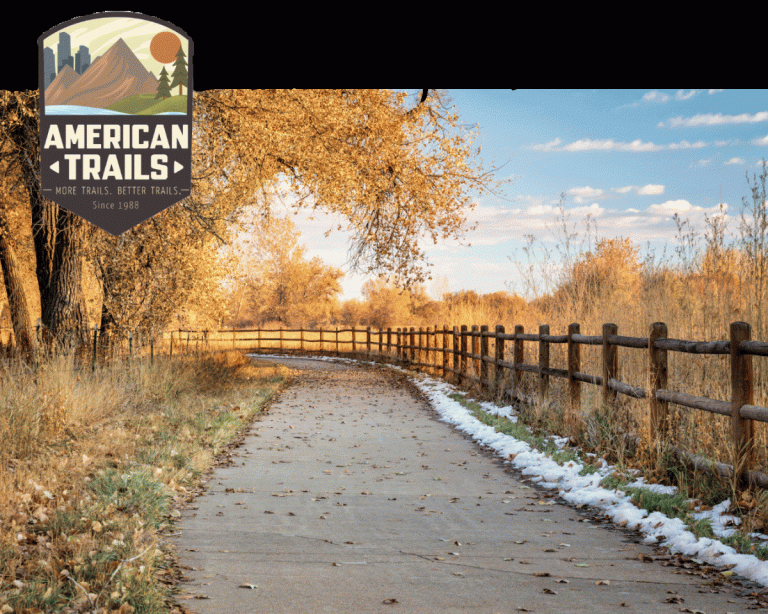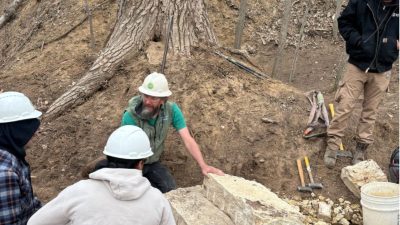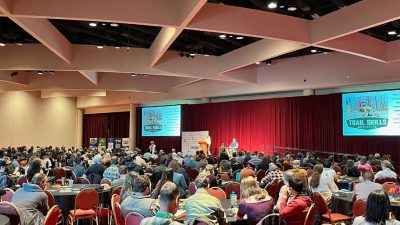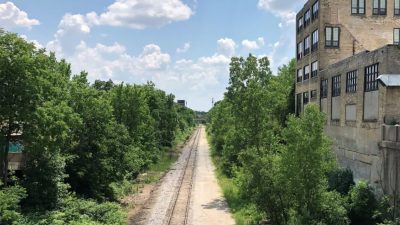
More than 850 attendees from 17 countries gathered April 15-17 in Madison, WI, for the 2025 International Trails Summit—a global celebration of learning, connection, and trail-centered inspiration.
The event opened with a powerful keynote by African American freelance journalist, author, outdoor guide James Edward Mills, setting the stage for three days packed with thought-provoking sessions and meaningful engagement. Whether it was exchanging ideas during networking events or watching Governor Evers operate a mini excavator at the Dirt Demo, the energy throughout the Summit was electric.
Memorable moments included Offsite Day with hands-on equipment demos and immersive field learning, youth
participation during NICA Trail Day, and the World Trails Film Festival, which highlighted inspiring global stories of perseverance, community, and the unifying magic of trails. –American Trails
Attending the 2025 American Trails Summit were SMGA trail crew members Cameron Herber and Brandon Smith. Their reflections on the event are below. The PowerPoint presentation they gave for the trail crew can be found below.
From Cameron:
Going to Madison for training was an amazing experience. The summit offered additional trainings on the weekends around the conference. I was able to complete a NOLS Wilderness First Aid Course and took a day trip to Milwaukee to see the 30th St. Corridor’s rail-with-trail project before the conference fully began. At the conference itself, I participated in sessions about so many different aspects of the work we do to make trails happen: trail construction techniques, funding, GIS, public engagement, environmentally resilient trails, signage, trail-user surveying and data-collection, community impacts and so much more.
The Milwaukee course was led by Willie Karidis with the Rails to Trails Conservancy. Willie is the Project Director for the Route of the Badger, a 700-mile interconnected trail system in and around Milwaukee. The trail system will be made up primarily of off-street trails (303 miles of which are already completed). The 30th Street Corridor specifically is an interesting project where they’re building a trail next to an active rail corridor as opposed to the more common practice of a rail to trail project.
There were around 850 people there for the summit. I got to hear people speak with such passion and determination about their trails projects, even in light of so many federal grants being revoked earlier this year. The intersection of people at the conference was eye opening to see. Municipal parks departments, nonprofits, back-country trail builders, researchers, and environmental groups were all there to talk and learn about the various aspects of trails and their impact on the places we live and recreate.



From Brandon:
I recently had the opportunity to attend the International Trails Summit in Madison, Wisconsin—a vibrant gathering of trail professionals from across the globe. It was a truly energizing experience, bringing together people from Hawaii, the West Coast, throughout the Midwest, the northernmost parts of Canada, and even trail builders from China. The diversity of attendees highlighted the global importance of trail networks and the rich variety of approaches to designing and maintaining them.
Among the many conversations, what stood out most was the depth of expertise represented—not just trail builders, but also landscape architects, city planners, and managers from private land conservancies. The summit fostered a broad and inspiring dialogue about the future of outdoor infrastructure and the many ways trails shape both ecological stewardship and public access to wild spaces.
I also took part in two particularly insightful seminars focused on trail systems that had faced catastrophic flooding—one in Asheville, North Carolina, and another in Wisconsin. Both municipalities had to rebuild extensively, but one common lesson emerged: trails with well-established native vegetation were the most resilient once the waters receded. In their rebuilding efforts, both cities turned to what they described as “native restoration greenhouses”—facilities dedicated to propagating local plant species—to reestablish lost sections and reinforce drainage systems with natural defenses. It was a powerful reminder of how ecological integrity and infrastructure resilience go hand-in-hand.
What felt particularly unique at the summit was the rarity of volunteer-based organizations like SMGA. It became clear that few other communities enjoy the kind of robust, cooperative relationship we have with our local city government. Our volunteers don’t just maintain trails—they help design and build them, actively shaping how people interact with natural spaces. That level of civic engagement and trust seems exceptional in the broader trail-building world, and I came away from the summit with a renewed appreciation for what we’ve built together in San Marcos.
